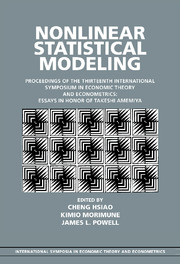 Nonlinear Statistical Modeling
Nonlinear Statistical Modeling Published online by Cambridge University Press: 05 June 2012
Introduction
This chapter considers the estimation of sample selection (SEL) models with polychotomous choices or multiple selection criteria.The focus is on the estimation of models which require estimation via simulation techniques. An example of such models is a model with multivariate normal disturbances. SEL models with polychotomous choices have been considered in Dubin and McFadden (1984), Lee (1983), and others, under extreme-value distributions. Schmertmann (1994) discussed limitations of these model specifications. In some empirical studies, in order to achieve simplicity, researchers imposed restrictive and unrealistic assumptions such as independence across disturbances of equations. Such practices resulted in controversies and debates (e.g., Duan et al. 1984, Hay and Olsen 1984). In many circumstances with complex selection criteria, multivariate normal disturbances may be the preferred specification (Amemiya 1974, Hausman and Wise 1978). With the development of simulation estimation methods, complex models can, in principle, be estimated (McFadden 1989, Pakes and Pollard 1989). Methods of simulated moments (MSM), simulated pseudolikelihood (SPL), and simulated maximum likelihood (SML) have been proposed in the literature (see McFadden 1989, Pakes and Pollard 1989, Lee 1992, Gourieroux and Monfort 1993, and Borsch–Supan and Hajivassiliou 1993). Parameter estimates may, however, be sensitive to simulators used (McFadden and Ruud 1994). The GHK simulator introduced by Geweke (1991), Borsch-Supan and Hajivassiliou (1993), and Keane (1994) provides an adequate probability simulator for the multinomial probit model. Monte Carlo results on comparing various simulation methods and simulators have mostly focused on discrete choice (DC) models (Hajivassiliou, McFadden, and Ruud 1996, Borsch-Supan and Hajivassiliou 1993, Geweke, Keane, andRunkle 1994, 1997).
To save this book to your Kindle, first ensure [email protected] is added to your Approved Personal Document E-mail List under your Personal Document Settings on the Manage Your Content and Devices page of your Amazon account. Then enter the ‘name’ part of your Kindle email address below. Find out more about saving to your Kindle.
Note you can select to save to either the @free.kindle.com or @kindle.com variations. ‘@free.kindle.com’ emails are free but can only be saved to your device when it is connected to wi-fi. ‘@kindle.com’ emails can be delivered even when you are not connected to wi-fi, but note that service fees apply.
Find out more about the Kindle Personal Document Service.
To save content items to your account, please confirm that you agree to abide by our usage policies. If this is the first time you use this feature, you will be asked to authorise Cambridge Core to connect with your account. Find out more about saving content to Dropbox.
To save content items to your account, please confirm that you agree to abide by our usage policies. If this is the first time you use this feature, you will be asked to authorise Cambridge Core to connect with your account. Find out more about saving content to Google Drive.